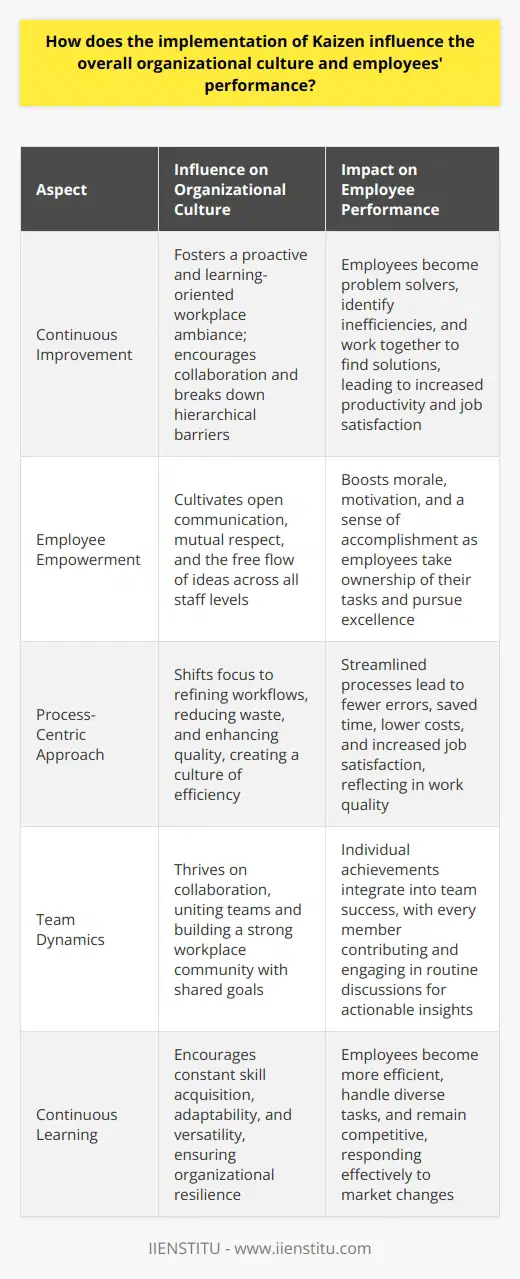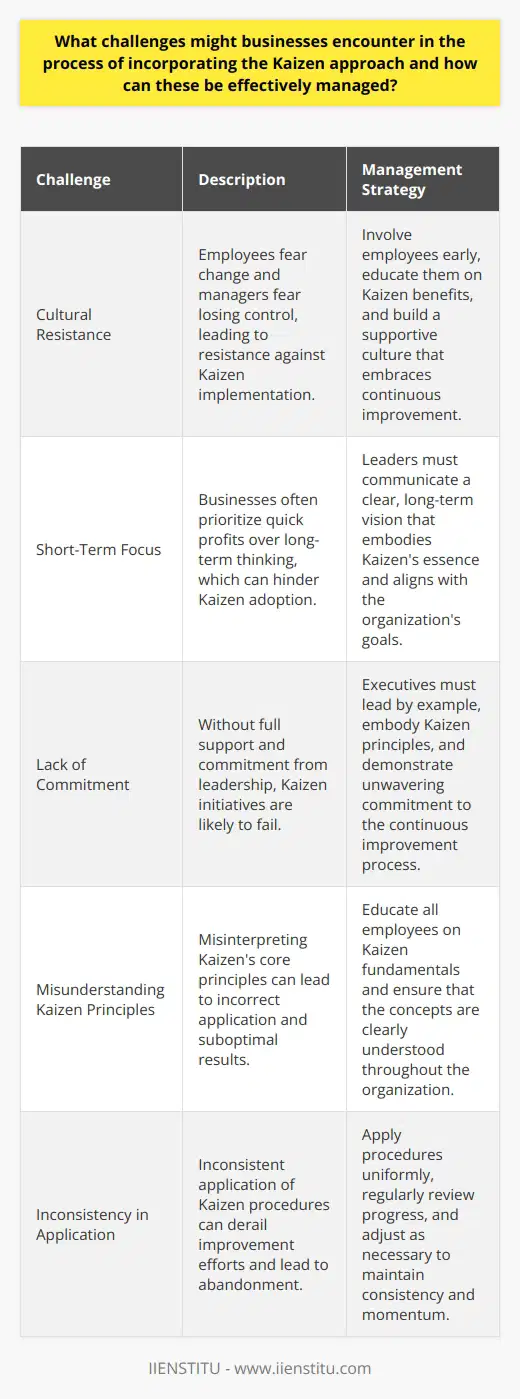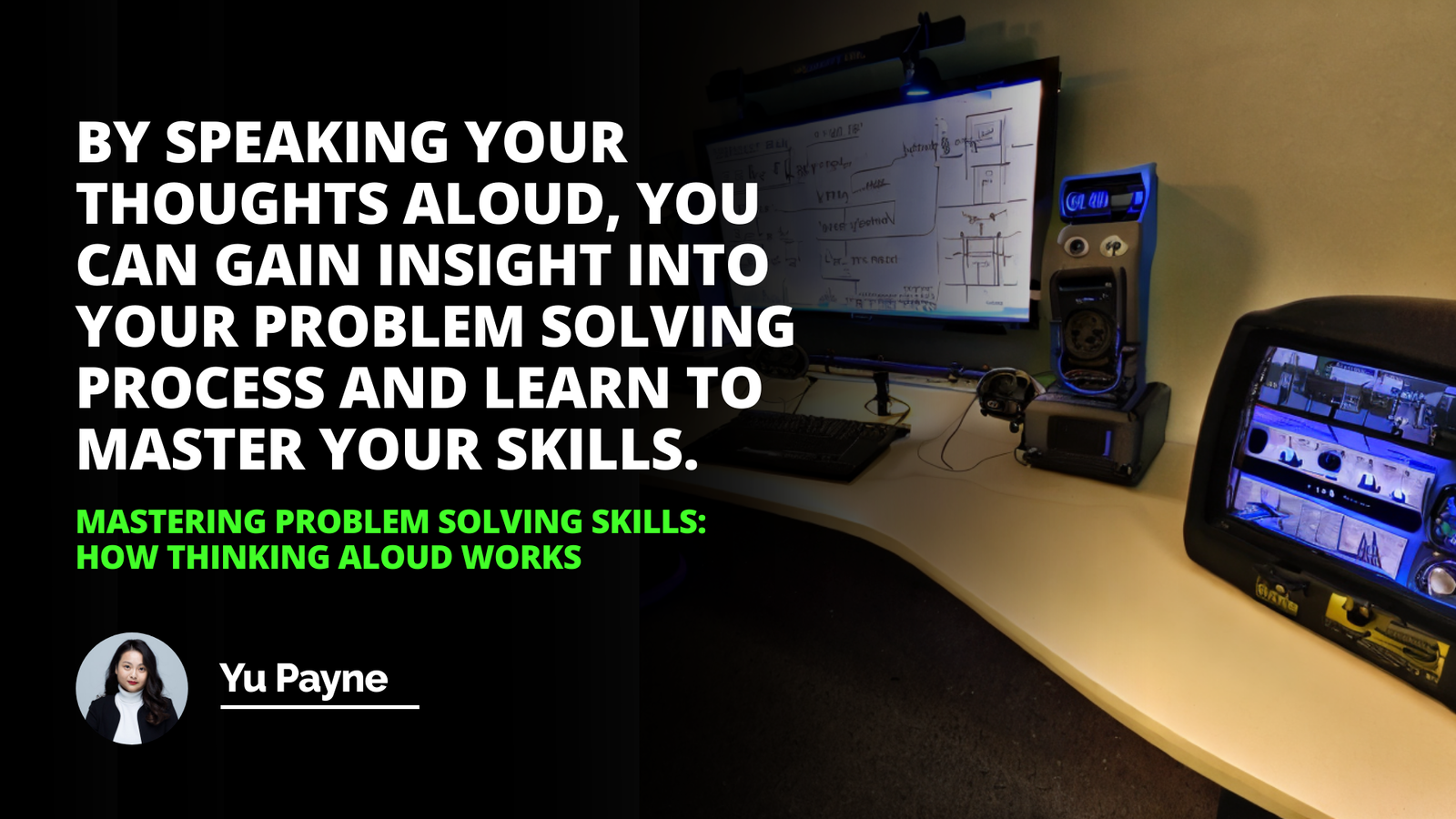
In the fast-paced, ever-changing world of business, organizations are constantly seeking ways to stay ahead of the curve. One philosophy that has gained significant traction in recent years is Kaizen, the Japanese concept of continuous improvement. Kaizen is not just a business strategy; it's a mindset that can transform the way individuals and organizations approach problem-solving and growth.
I first encountered Kaizen during my time working at a manufacturing company. The company had been struggling with inefficiencies and quality issues, and the management decided to implement Kaizen principles to turn things around. At first, I was skeptical. How could small, incremental changes lead to significant improvements? But as I witnessed the transformation firsthand, I became a believer in the power of Kaizen.
In this blog post, we'll dive deep into the world of Kaizen. We'll explore its origins, key principles, and how it can be applied in both business and personal contexts. We'll also look at real-world examples of organizations that have successfully implemented Kaizen and the benefits they've reaped as a result.
What is Kaizen?
Kaizen is a Japanese term that translates to "change for the better" or "continuous improvement." It's a philosophy that focuses on making small, incremental changes on a regular basis to improve quality, efficiency, and productivity.
The concept of Kaizen was first introduced in Japan following World War II. At the time, the country was facing significant economic challenges, and Japanese businesses were looking for ways to improve their competitiveness. Kaizen was seen as a way to optimize manufacturing processes and reduce waste.
Key Principles of Kaizen
At its core, Kaizen is based on several key principles:
Continuous Improvement: The belief that there is always room for improvement, no matter how small.
Employee Involvement: The idea that all employees, from the CEO to the front-line workers, should be actively engaged in the improvement process.
Process Focus: The emphasis on improving processes rather than just focusing on results.
Data-Driven Decision Making: The use of data and metrics to identify areas for improvement and measure progress.
Standardization: The creation of standard operating procedures to ensure consistency and reduce variability.
By embracing these principles, organizations can foster a culture of continuous improvement and drive long-term success.
Kaizen in Business
Kaizen has been widely adopted in the business world, particularly in manufacturing and operations. Many companies have used Kaizen principles to streamline their processes, reduce waste, and improve quality.
Case Study: Toyota
One of the most well-known examples of Kaizen in action is Toyota. The Japanese automaker has long been a proponent of continuous improvement, and its Toyota Production System (TPS) is based on Kaizen principles.
At Toyota, every employee is encouraged to identify areas for improvement and suggest changes. These suggestions are then evaluated and implemented if they are deemed to be beneficial. This approach has helped Toyota become one of the most efficient and profitable automakers in the world.
Implementing Kaizen in Your Organization
If you're interested in implementing Kaizen in your own organization, there are several steps you can take:
Educate Your Team: Make sure everyone in your organization understands the principles of Kaizen and how they can contribute to the improvement process.
Identify Areas for Improvement: Use data and metrics to identify areas where your processes can be optimized.
Encourage Employee Involvement: Create a culture where all employees feel empowered to suggest changes and improvements.
Start Small: Remember, Kaizen is about making small, incremental changes. Don't try to overhaul your entire operation overnight.
Measure Progress: Use metrics to track the impact of your Kaizen initiatives and identify areas for further improvement.
By following these steps and embracing the principles of Kaizen, you can drive significant improvements in your organization over time.
Kaizen Beyond Business
While Kaizen is often associated with business and manufacturing, its principles can be applied in many other contexts as well.
Kaizen in Personal Development
Kaizen can be a powerful tool for personal growth and development. By focusing on making small, incremental improvements in your life, you can achieve significant progress over time.
For example, let's say you want to improve your physical fitness. Rather than trying to overhaul your entire lifestyle overnight, you could start by making small changes like taking the stairs instead of the elevator or going for a short walk every day. Over time, these small changes can add up to significant improvements in your health and well-being.
Kaizen in Education
Kaizen principles can also be applied in educational settings. By continuously seeking ways to improve teaching methods, curriculum, and student outcomes, educators can drive meaningful change in the classroom.
For example, a teacher might use Kaizen principles to identify areas where students are struggling and develop targeted interventions to help them succeed. By continuously monitoring student progress and making adjustments as needed, the teacher can help all students reach their full potential.
The Benefits of Kaizen
Implementing Kaizen can bring a wide range of benefits to individuals and organizations alike. Some of the key benefits include:
Increased Efficiency: By continuously improving processes and reducing waste, Kaizen can help organizations become more efficient and productive.
Improved Quality: Kaizen's focus on continuous improvement can lead to higher quality products and services.
Enhanced Employee Engagement: By involving all employees in the improvement process, Kaizen can foster a sense of ownership and engagement among team members.
Greater Customer Satisfaction: By consistently delivering high-quality products and services, organizations that embrace Kaizen can improve customer satisfaction and loyalty.
Long-Term Success: Kaizen is not a one-time initiative, but rather a long-term approach to continuous improvement. By embracing Kaizen principles, individuals and organizations can drive sustained success over time.
Challenges and Considerations
While Kaizen can bring significant benefits, it's important to be aware of some of the challenges and considerations involved in implementing this approach.
Resistance to Change
One of the biggest challenges in implementing Kaizen is overcoming resistance to change. People are often comfortable with the status quo and may be hesitant to embrace new ways of doing things.
To overcome this resistance, it's important to communicate the benefits of Kaizen clearly and involve all stakeholders in the improvement process. By creating a sense of ownership and empowerment among team members, you can help build buy-in and support for Kaizen initiatives.
Resource Constraints
Another challenge in implementing Kaizen is resource constraints. Continuous improvement initiatives require time, money, and personnel to be successful. Organizations may struggle to allocate these resources, particularly in times of economic uncertainty.
To address this challenge, it's important to prioritize Kaizen initiatives based on their potential impact and ROI. By focusing on the areas that will bring the greatest benefits, organizations can make the most of limited resources.
Sustaining Momentum
Finally, sustaining momentum can be a challenge in Kaizen initiatives. It's easy to get excited about improvement efforts in the beginning, but maintaining that enthusiasm over time can be difficult.
To sustain momentum, it's important to celebrate successes along the way and communicate progress regularly. By highlighting the impact of Kaizen initiatives and recognizing the contributions of team members, you can help keep everyone motivated and engaged.
Conclusion
Kaizen is a powerful philosophy that can transform the way individuals and organizations approach problem-solving and growth. By embracing the principles of continuous improvement, employee involvement, and data-driven decision making, we can drive meaningful change and achieve long-term success.
Whether you're a business leader looking to optimize operations, an educator seeking to improve student outcomes, or an individual striving for personal growth, Kaizen offers a framework for sustained improvement and development.
Of course, implementing Kaizen is not without its challenges. It requires a willingness to embrace change, allocate resources, and sustain momentum over time. But for those who are committed to the journey of continuous improvement, the benefits can be truly transformative.
As someone who has seen the impact of Kaizen firsthand, I encourage you to explore how these principles can be applied in your own life and work. Whether you start small or go all-in, the power of Kaizen lies in its ability to drive meaningful, lasting change. So embrace the journey of continuous improvement – you never know where it might take you.
Frequently Asked Questions
What are the fundamental principles underpinning the Kaizen strategy and how do they contribute to business success?
Introduction to Kaizen
Kaizen represents continuous improvement. It originated in Japan, post-World War II. This strategy became central to Japanese business philosophy. Today, it influences organizations globally. Kaizen rests on several core principles. Together, these principles foster persistent business enhancement. They encourage employee participation and emphasize process-oriented thinking.
Core Principles of Kaizen
Continuous Improvement
Change is constant in Kaizen. Incremental enhancements matter greatly. They lead to significant improvements over time. Continuous improvement defies complacency. It promotes a growth mindset across the organization.
Good Processes Bring Good Results
Focus on the process, not merely outcomes. Kaizen teaches us that quality processes yield desired results. Streamlined processes eventually produce efficiencies and success. Attention to workflow intricacies can reveal opportunities.
Important Elements in Kaizen Strategy
Customer Orientation
The customer takes center stage. Understand customer needs deeply. Customer satisfaction drives all improvement efforts. Align business objectives with customer expectations. A satisfied customer base propels business growth.
Waste Elimination
Waste reduction is paramount in Kaizen. Identify non-value-adding activities. Eliminate or minimize these. Efficiency gains translate into better performance. Resources saved can fuel further innovation.
Empowerment of Employees
Employee involvement is critical. Employees can offer valuable insights. They understand the daily work processes best. Harness their ideas for improvement. Empowerment leads to a motivated workforce.
Standardization
Establish clear standards. Work towards consistent processes. Standardization ensures stability and predictability. It lays the foundation for future improvements. It helps maintain gains achieved through Kaizen.
Business Success Attributed to Kaizen
Enhanced Productivity
Kaizen promotes a meticulous examination of procedures. Improved processes boost productivity. Greater productivity can drive profitability. Efficiency often results in competitive advantage.
Improved Quality
Constant attention to quality matters. Kaizen emphasizes defect prevention. Enhanced quality can lead to higher customer satisfaction. Brand reputation can thus significantly improve.
Flexibility and Adaptability
Kaizen fosters a culture of adaptability. Businesses can respond swiftly to changes. This agility can become a strategic asset. It allows companies to thrive in volatile markets.
Employee Morale and Engagement
Kaizen values every employee's contribution. Engaged employees tend to perform better. Higher morale often leads to lower turnover. Companies with committed workforces enjoy stability and innovation.
Reduced Costs
By eliminating waste, costs reduce. Streamlined operations incur fewer expenses. Cost reduction is a direct path to improving margins. Financial stability can ensure long-term success.
Conclusion
Kaizen is more than just an improvement tool. It embodies a philosophy that integrates critical principles. These principles guide organizations toward sustainable growth. They place emphasis on customer satisfaction, process perfection, and empowerment. Kaizen's real strength lies in its collaborative and incremental nature. Long-term commitment to Kaizen can transform business operations. It equips businesses with resilience to face future challenges.

How does the implementation of Kaizen influence the overall organizational culture and employees' performance?
Kaizen and Organizational Culture
Kaizen embodies continuous improvement. It shapes corporate climates. Employees engage in persistent, incremental enhancement. This philosophy fosters a proactive workplace ambiance. It promotes a learning environment. Workers become problem solvers. They learn to identify inefficiencies. They collaborate to find solutions. Kaizen breaks down hierarchical barriers. All staff levels participate. Ideas flow freely. Entry-level voices gain importance. Kaizen reinforces mutual respect. It cultivates open communication. Feedback becomes routine. It's a culture of ongoing development.
Employee Performance Enhancement
Kaizen directly affects performance. It encourages regular introspection. Workers assess their own practices. They spot improvement opportunities. Each small enhancement accumulates. Productivity rises. Employees gain a sense of accomplishment. This boosts morale. Higher morale leads to increased motivation. Motivated employees often show better performance. They embrace challenges. They pursue excellence. They take ownership of their tasks. Kaizen transforms mindsets. The focus shifts to quality over quantity.
The Process-Centric Approach
Kaizen emphasizes processes. It looks less at outcomes. The idea stands: good processes yield desired results. Employees concentrate on refining workflows. They reduce waste. They streamline operations. They enhance quality. These process improvements lead to superior outcomes. It reduces errors. It saves time. It lowers costs. Employees experience less frustration. Better processes lead to job satisfaction. Job satisfaction reflects in their work quality.
Team Dynamics and Collaboration
Kaizen thrives on teamwork. It demands collaboration. Individual achievements integrate into team success. Every member contributes. They share a common goal: improvement. Team meetings are routine. Discussions focus on progress. They yield actionable insights. Every suggestion holds value. This joint effort unites teams. It builds a strong community within the workplace.
Staff Empowerment and Accountability
Kaizen empowers workers. They have authority to suggest changes. They make decisions affecting their work. This empowerment brings responsibility. Employees hold themselves accountable. They aim for high standards. Responsibility fosters commitment. Workers care for their tasks. They ensure execution to perfection. Accountability promotes a diligent workforce.
Continuous Learning and Adaptability
Kaizen encourages learning. Employees constantly acquire new skills. They adapt to changes. They become versatile. They handle diverse tasks. Adaptability becomes a core skill. The workforce remains competitive. They can respond to market changes. Flexibility is an asset. It assures organizational resilience.
Long-Term Impacts on Culture and Performance
Implementing Kaizen leaves lasting impacts. It instills a culture of excellence. The workforce evolves. It becomes more efficient. It improves steadily. Performance metrics reflect this evolution. Organizations witness sustainable growth. They achieve competitive advantages. Kaizen shapes not just operations. It molds mindsets. It builds foundations for enduring success.

What challenges might businesses encounter in the process of incorporating the Kaizen approach and how can these be effectively managed?
Understanding Kaizen
Kaizen signifies continuous improvement. It focuses on incrementally improving products, processes, or services by eliminating waste. Businesses often adopt Kaizen to boost efficiency, productivity, and employee satisfaction.
Challenges in Adopting Kaizen
Cultural Resistance
Change scares people. Kaizen requires a culture shift. Employees fear the unknown. Managers fear losing control. Cultural resistance thus emerges as the chief hurdle.
Short-Term Focus
Businesses often hunt quick profits. Kaizen demands long-term thinking. This mismatch can stall implementation.
Lack of Commitment
Leadership must back Kaizen. Without their full support, initiatives fail.
Misunderstanding Kaizen Principles
Kaizen seems simple. However, misinterpreting its core principles leads to wrong application.
Inadequate Training
Employees need proper guidance. Lack of training results in poor execution.
Communication Breakdown
Effective communication ensures a united team. Without it, confusion reigns.
Inconsistency in Application
Inconsistency derails improvement. It leads to procedure abandonment.
Managing Kaizen Challenges
Building a Supporting Culture
Engagement is key. Involve employees early. Make them part of the change. Educate on Kaizen benefits.
Long-Term Vision Setting
Leaders must communicate a clear vision. This vision should embody Kaizen's essence.
Ensuring Leadership Commitment
Executives must lead by example. They should embody Kaizen principles.
Clear Understanding of Principles
Educate everyone on Kaizen fundamentals. Ensure the concepts are clear.
Focused Training Programs
Offer comprehensive Kaizen training. Refine skills through regular workshops.
Maintaining Open Communication
Keep lines of communication open. Address concerns promptly. Celebrate successes widely.
Consistent Approach
Apply procedures uniformly. Regularly review and adjust as necessary.
Conclusion
While challenges exist, thoughtful management can overcome them. It requires dedication, adaptability, and clear communication. Businesses can fully harness the power of Kaizen by focusing on these areas. The outcome is an ever-improving organization that thrives on change and continual enhancement.



